This is the second half of the latest instalment in our ongoing survey of covering options for the new breeding season. The first part can be read here.
UPSTART (Flatter–Party Silks, by Touch Gold) was cleverly named and I think him a very plausible type, likely to rise pretty quickly through the ranks. Certainly there were more than enough “nouveaux riches” among his first juveniles–only Not This Time exceeded his 19 winners (from 54 starters)–for him to be pegged at $10,000 by Airdrie. His principal earner was Reinvestment Risk, who twice chased home speedball Jackie’s Warrior (Maclean’s Music) in Grade Is after romping on debut at Saratoga, but a measure of what may be coming down the tracks was the 12-length debut success of Manor House at Laurel just before Christmas.
Remember Upstart himself was multiple Grade I-placed at two, three and four, so expect him to keep consolidating from an opening book of 146 and in the process to ride out a dip in numbers since to 86 and then just 38. Very auspiciously, his first yearlings (whose $63,608 average exceeded six times his fee) prompted renewed traffic last spring to 90 mares. And actually his second crop maintained value and demand far better than most, 41 of 47 selling for another very fertile yield, relatively speaking, at $45,159. In the meantime he had also excelled in a challenging 2-year-old market, his $104,400 average giving him virtual parity with a far more expensive pair in Nyquist and Frosted.
There’s no mistaking professional enthusiasm for Upstart’s stock, physically. But the key is that the speed shown by his earlier types is just a foundation; they’re bred and built to stretch, too. I can’t imagine that Flatter has had another juvenile clock a triple-digit Beyer, and there’s a really wholesome depth and balance to his pedigree.
His dam, a half-sister to a Grade II winner, is by Touch Gold–who combines distaff legends Deputy Minister and Buckpasser. This just looks so good opposite the Secretariat-Buckpasser combination behind Weekend Surprise, mother of Flatter’s sire A.P. Indy.
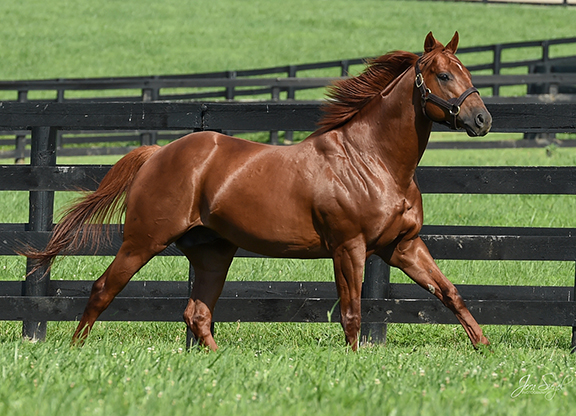
Speightster | PM Photos
One at the same fee who did even better in terms of holding the value of his second crop was SPEIGHTSTER (Speightstown–Dance Swiftly, by Danzig), no mean achievement given the sheer volume he had generated at WinStar.
Having opened up with a $63,680 dividend, virtually identical with Upstart, for 71 yearlings sold from no fewer than 97 offered in his first crop, Speightster managed $59,153 for 43 of 58 offered this time round. That was sufficient to secure fifth in the averages, and represents a quite remarkable vote of confidence after a solid 15 winners from 63 starters. A couple of those scored at black-type level, though perhaps nothing Speightster has done so far quite equalled the splash of his $1.1 million son at OBS in the summer.
His profile contrasts sharply with that of Upstart, having blitzed his first three (sophomore maiden/allowance/GIII Dwyer) before derailing on only his fourth start. That may or may not have been the tip of an iceberg, but the pedigree could hardly have been more auspicious. What a frisson, nowadays, just to see a dam by Danzig–never mind one who is sister to Dance Smartly and half-sister to Smart Strike. This is obviously one of the great Canadian dynasties, while a physical resemblance to his farm’s venerable patriarch can only aid Speightster’s cause in contesting the succession. He has relentless numbers behind him, too, having opened with books of 174, 150, 124 and 152, so one way or another there’s a lot of belief out there.
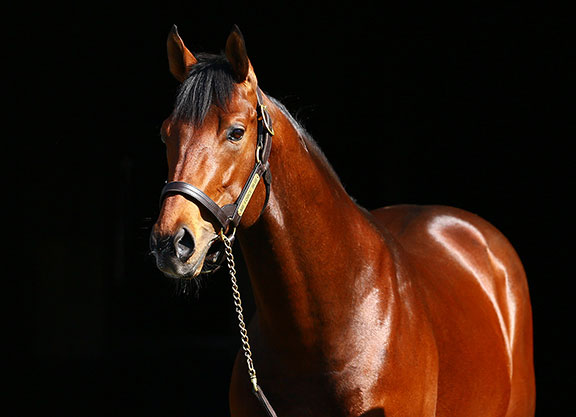
Air Force Blue | Coolmore
His buoyancy offers a curious contrast with another who prizes Danzig in the second generation. The first juveniles of AIR FORCE BLUE (War Front–Chatham, by Maria’s Mon) performed to a very similar level–in fact more winners from fewer runners (17 from 46), albeit just couldn’t crack a stakes win–but who suffered quite a slide in the value of his second crop of yearlings: his 34 sales (of 50) this time round realizing $46,145, down from the $98,230 (albeit for only 44 sold of 73 into the ring) on his sales debut.
One obvious difference is that Ashford started him at $25,000, but he has taken repeated trims and is now down to $10,000. Another is that Air Force Blue failed to go on after a sensational juvenile career, so we’ll now be looking for him to draw on his pedigree to keep his stock progressing with maturity. That’s certainly possible: his second dam is full-sister to Flanders (Seeking the Gold), a champion herself and dam of another in Surfside (Seattle Slew), while copper-bottomed influences seed his entire family tree. But you suspect the biggest hesitation has been a reputation made on turf, such a culpable prejudice in the commercial market.
In fact nine of his 17 winners scored on dirt, and this horse deserves a fresh chance at such a friendly fee. He was a genuinely top-class juvenile for Ballydoyle and it looks a really positive sign that the conveyor belt picked up again last spring when opening books of 153, 106 and 90 were followed by one of 135.
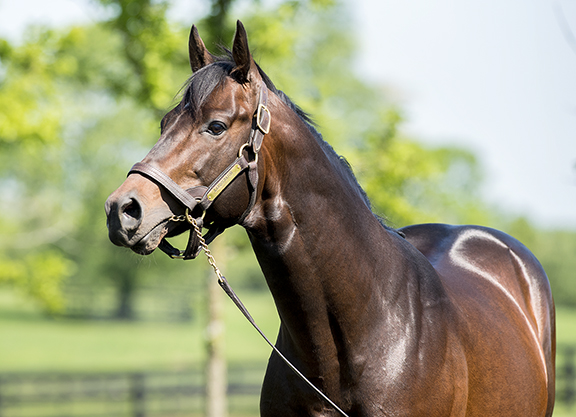
Exaggerator | Sarah Andrew
Nobody threw numbers at the track in the same volume as EXAGGERATOR (Curlin–Dawn Raid, by Vindication), so 14 winners from as many as 69 starters has to go down as pretty tepid. As many as five, however, managed a stakes podium. Having launched at WinStar off $30,000, he housed 63 of 103 yearlings in his first crop for $85,746 but it proved tough going for his 76 into the ring this time, 56 processed at just $25,982. He has taken a third consecutive cut, to $15,000, but will maintain the numbers after a fourth book of 104, having opened with 162, 163 and 129.
If this is the kind of industrial process that makes some of us uncomfortable, then Exaggerator did at least demonstrate some old-school wares in banking $3.6 million through 15 starts in 16 months, actually bookending his career in the same races as Nyquist. The pair also exchanged verdicts in the Derby and Preakness, one of three Grade I prizes won by an admirable racehorse of good Canadian family. You’d expect Exaggerator’s stock to keep thriving, then, as and when finding their stride.
The same farm launched TOURIST (Tiznow–Unbridled Melody, by Unbridled’s Song) at $12,500 but has had to make repeated cuts, now to $5,000, after failing to find any commercial traction with his first two crops: the first realized $27,996 for 41 sales (of 58 offered) and this time round he was down to $14,533 for 16 of 23. With his books dwindling–134, 102, 70 and 60–he needs his stock to stick to the program, having himself improved relentlessly through four campaigns until ultimately shocking Tepin (Bernstein) in the GI Breeders’ Cup Mile in a race-record 1:31.71. He laid a feasible base with 13 winners from 43 starters, and the market’s distaste for turf meant that he would always be a longer-term project.
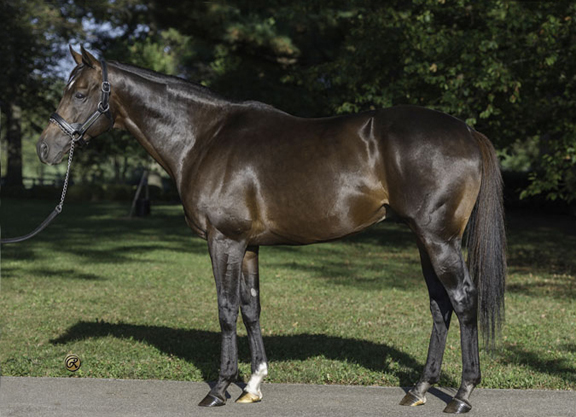
Flintshire | Louise Reinagel
Speaking of grass, you can only despair that a horse as accomplished as FLINTSHIRE (GB) (Dansili {GB}–Dance Routine {GB}, by Sadler’s Wells) should struggle for patronage in Kentucky. Hill ‘n’ Dale at Xalapa now offers him at $10,000, half his opening fee, after his fourth book sank to just 38. Nobody could be surprised, given his own template, that he mustered only half a dozen winners from his first 36 juveniles. But the fact is that anyone far-sighted enough to support him now will be able to ride the wave as his strong early support from an ownership group including Juddmonte plays out (opened with 121, 89 and 69) in his maturing stock.
It’s tiresome to hear people talk so reverently about expanding turf opportunities, or the importance of soundness, when they don’t seem to respect even this nugget from the Juddmonte program: by one of the best-bred stallions in Europe out of a Classic-placed mare, he became its richest-ever graduate as a five-time Grade/Group I winner of $9.5 million (also dual Arc runner-up) whose turn of foot was measured at :44.56 for his closing half-mile in the GI Manhattan. His first crop of yearlings had fared reasonably well, clearing as many as 45 of 52 at $46,686, but 14 of 25 this time round scraped together a yield of $19,552. But you reap what you sow and if this industry can only make fast, precocious dirt horses pay, it will someday learn to regret it.
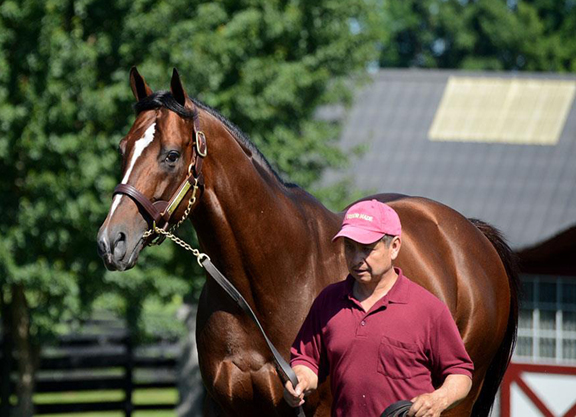
Mshawish | Taylor Made
Turf is only one of the strings to the bow of MSHAWISH (Medaglia d’Oro–Thunder Bayou, by Thunder Gulch), fourth of 19 in the G1 Prix du Jockey Club before being imported to win Grade Is, on both surfaces, at five and six. He has taken another cut at Taylor Made, now down to $7,500 from an opening $20,000, despite mustering a solid 13 winners from 42 starters.
That reflects the usual dwindling books (just 40 mares last spring, down from 117, 73 and 68) and a dip by his second crop of yearlings to an average $16,515, for 14 of 19 sold, down from $39,338 for 42 sales from 56 first time round. But he remains a very wholesome option with his seven consecutive triple-digit Beyers and average earnings of $100,000 per start through 24 races. His versatility is not just down to his sire, with a dam inbred 3×3 to Storm Bird; while his granddam is a half-sister to the mother of champion Halfbridled (Unbridled). As a longer play, still every chance.
The Albaugh Family team, which brought us Not This Time, offers a value alternative by the same sire in BRODY’S CAUSE (Giant’s Causeway–Sweet Breanna, by Sahm) at Spendthrift. He made quite an impression with his first juveniles: only half a dozen winners (from 29 starters) but they were good ones: two won at stakes level and four made the podium in graded stakes, notably GIII Iroquois S. winner Sittin On Go and GI Starlet S. runner-up Kalypso, who has since won the GII Santa Ynez S. on the third day of her sophomore career.
Like Not This Time, he extends a regal bottom line: his fourth dam, indeed, is by Dr. Fager out of a Bold Ruler half-sister to Secretariat’s dam Somethingroyal. His second dam was Grade I-placed and Brody’s Cause himself won Grade I races at two and three and, while he didn’t last the course, had established himself among the best of his generation and looks a bet to nothing now that he is down to $5,000 from an opening $12,500. He does have some weight of numbers, too, with initial books of 101 and 110 before dipping to 63 and 49. After a promising debut at the sales (33 sold of 51 yearlings at $50,166), he was another to struggle with his second crop (27 sold of 34 at $25,596) but he is definitely, definitely still in the game–and a viable sanctuary for those priced out of Not This Time.
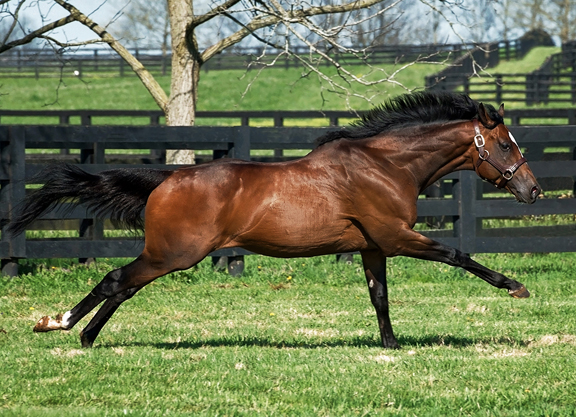
Hit It a Bomb | Spendthrift
On the same farm, HIT IT A BOMB (War Front–Liscanna {Ire}, by Sadler’s Wells) has given himself a squeak at the same fee–not just with GII Best Pal winner Weston among his handful of winners, but also with a startling $330,000 colt at Fasig-Tipton in September. That boosted his second-crop average to $47,916 for a dozen sold of 15, but even a $23,500 median was solid after 15 in his first crop averaged $30,153 (median $13,000).
These are hardly the industrial numbers familiar on this farm but actually he rallied to 47 mares last spring from a third book of just 20, after opening with 48 and 49. It’s all chlorophyll, obviously, but the GI Breeders’ Cup Juvenile Turf winner is brother to another juvenile Group 1 scorer from a classy family.
Another down to the bottom tier at Spendthrift is CINCO CHARLIE (Indian Charlie–Ten Halos, by Marquetry), though he managed no fewer than 14 winners from just 31 starters, including one at stakes level. He also made quite a stir with a $200,000 filly at the Fasig-Tipton Midlantic 2-Year-Old Sale, albeit seven second-crop yearlings (from 10 into the ring) realized just $6,600 down from $20,944 (for 19 of 26) first time round. Cinco Charlie did match his precocity (GIII Bashford Manor S. second time out) with hardiness, racking up seven black-type wins in 18 starts, so don’t rule out farther progress; while his second dam is by none other than Halo.
We know to expect interesting stallions at Crestwood and TEXAS RED (Afleet Alex–Ramatuelle {Chi}, by Jeune Homme), rather wonderfully, has earned a hike in fee to $10,000 from $7,500 after pulling GII Sorrento S. winner My Girl Red out of his hat. She was among eight scorers from just 19 starters.
Texas Red will have to ride out a couple of quieter years but opening books of 81 and 67 give scope for consolidation and he was, after all, a brilliant runner. His 104 Beyer romping at the Breeders’ Cup was backed up in an interrupted sophomore campaign, beating Frosted in the GII Jim Dandy besides running a top-class sprinter in Lord Nelson (Pulpit) to a neck over seven furlongs. A classy South American family also makes him a very accommodating outcross.
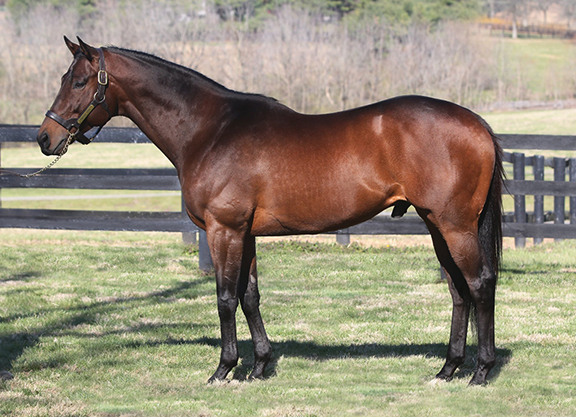
Firing Line | Crestwood
Studmate FIRING LINE (Line of David–Sister Girl Blues, by Hold for Gold) works from a narrow base but had four winners from his 13 starters. He had sold 20 of 21 yearlings in his first crop, including a colt and filly that each made six figures, while one of his daughters soared to $210,000 at OBS in June. If things were quieter for his yearlings this time round, Firing Line retains plenty of interest on performance, denied a Grade I at two only by a nose and the Derby itself only by a Triple Crown winner; and also on pedigree, his dam a Grade I-placed sibling to the mothers of two Grade I-winning milers, their line extending to matriarchs Kamar (Key to the Mint) and Square Angel (Quadrangle).
Another to give striking encouragement from a small base is TAMARKUZ (Speightstown–Without You Babe, by Lemon Drop Kid) at Shadwell. From just 14 runners, he had five winners including GIII Bob Hope S. winner Red Flag and, though lacking numbers (third book was highest at 57), might merit a roll of the dice at $7,500 from an opening $12,500.
Having bowed out beating the next two winners of the Breeders’ Cup Classic in the GI Dirt Mile, Tamarkuz is out of a half-sister to two GI Belmont S. runners-up who has also produced a Group 1 miler in Without Parole (GB) (Frankel {GB}). You have to love a second dam by Storm Bird opposite his son Storm Cat as Speightstown’s damsire, and the maternal line tapers to some resonant names.
Wins from two to six suggest that his stock will keep flying the flag with maturity; and he also showed versatility in terms of surface. Though his first yearlings excelled, moving on 18 of 20 yearlings at $68,222, a handful of his second crop made no money to speak of. But one of only four hips at the 2-year-old sales made $160,000, and Tamarkuz should definitely interest anyone out there who might want to breed an actual racehorse for a small fee.
Beating Tamarkuz for the GII Kelso H. in 1:32.9 is the poster achievement for ANCHOR DOWN (Tapit–Successful Outlook, by Orientate), now $5,000 from an opening $10,000 at Gainesway. Eight winners from 18 runners was a very good start, given his small books, and he’s a half-brother to GI Test S. winner Sweet Lulu (Mr. Greeley). His sale yields are pretty standard for this level, but it should be noted that his clearance rate for both crops of yearlings were extremely high and he also went down well at the 2-year-old sales, with a $270,000 colt and $200,000 filly. Competition is obviously tough among heirs to the farm’s champion but less so at this level.
There are a handful of others in this intake whose numbers are too precarious to repay much dredging. But the likes of BIG BLUE KITTEN (Kitten’s Joy–Spent Gold, by Unaccounted For) and PRODUCER (GB) (Dutch Art {GB}–River Saint, by Irish River {Fr}) at Calumet, or V. E. DAY (English Channel–California Sunset, by Deputy Minister) at Buck Pond Farm, were always going to be longer-term projects and so remain entitled to repay perseverance.
And we should highlight a conspicuous achievement apiece by three who share the same, great damsire: $2,500 cover OPTIMIZER (English Channel–Indy Pick, by A.P. Indy) at Calumet, for pulling a $190,000 filly out of his hat at Keeneland in September; IRONICUS (Distorted Humor–Meghan’s Joy, by A.P. Indy) for coming up with an unbeaten stakes winner from his small footprint from Claiborne at $5,000; and PROTONICO (Giant’s Causeway–Alpha Spirit, by A.P. Indy), at the same fee, for a potentially game-changing start to 2021.
A rootless start to his stud career can hardly have helped his cause. Yet his three winners from eight starters include Medina Spirit, a $1,000 yearling who closed to within a length of the Derby favorite in the GIII Sham S. Protonico’s second dam is Chilean Horse of the Year and Grade I winner Wild Spirit (Chi) (Hussonet), and a half-length miss in the GI Clark H. left him cents short of millionaire status. Medina Spirit is the kind of flagship that would be trumpeted from the rooftops by farms who throw 200 mares at rookie stallions, so to come up with this dude from an opening book of 34 entitles Castleton Lyons to hope that he could yet claw his way from the back lanes to the highway.
That’s the kind of frayed highwire all these horses are walking now. And while many will lose their footing, the great thing is that some of them are suddenly going to break into a run.
CHRIS McGRATH’S VALUE PODIUM
Gold: Frosted ($25,000, Darley)
A champion at the right distance, out of a Deputy Minister mare, and no less likely to succeed now than when he was $50,000.
Silver: Upstart ($10,000, Airdrie)
His record and pedigree guarantee that a fine start by his juveniles is only the beginning.
Bronze: Speightster ($10,000, WinStar)
A lot of people seem adamant that he’s about to take off.

The post Kentucky Sires for 2021: First Sophomores–Part II appeared first on TDN | Thoroughbred Daily News | Horse Racing News, Results and Video | Thoroughbred Breeding and Auctions.
Source of original post








